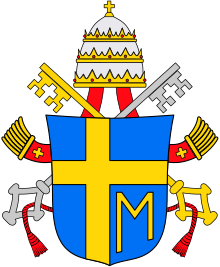Fides et ratio
Fides et ratio (Faith and Reason) of September 14, 1998 is the thirteenth and penultimate encyclical of Pope John Paul II. It has the subtitle: To the Bishops of the Catholic Church - on the relationship between faith and reason . In eight steps, the text goes from the introductory call for self-awareness to the description of current demands and tasks.
The correct understanding of the revelation of God's wisdom and the axioms Credo ut intellegam (“I believe in order to understand”) and Intellego ut credam (“I understand in order to believe”) are explained in order to build on the right relationship between faith and To formulate reason, to justify the requests to speak of the teaching office in the philosophical field and to emphasize the interaction between theology and philosophy . It begins with the opening words that faith and reason are like the two wings with which the human mind arises to contemplate the truth. According to natural theology , God himself can be recognized as the truth.
The encyclical maintains that, from the point of view of faith, a ratio recta is required to penetrate revelation intellectually. Hence, not every philosophy is compatible with Christianity, nor is it possible to arrive at a full understanding of Catholic doctrine from any modern conception. However, the Pope has expressly recognized that faith approves of a variety of philosophical concepts as long as none is considered normative in relation to dogma . The Thomism remains an exemplary concept, is not considered as the only possible way of thinking. In this respect, the Pope also brings, in an updated form, warnings from his predecessor Leo XIII. , Pius X. (see also the encyclical Pascendi from 1907) and Pius XII. in remembrance.
literature
- Karl-Heinz Menke : The one truth. The central concern of the encyclical "Fides et Ratio" , in: Rheinischer Merkur 54 (1999) No. 7, pp. 25-26.
- Jörg Splett : "Fides et Ratio". Philosophically read , in: Münchener Theologische Zeitschrift 51 (2000), pp. 63–79.
- Paul Weingartner: Faith and Reason. Interdisciplinary debate on the encyclical Fides et ratio . Lang, Frankfurt am Main 2004, ISBN 3-631-50723-2 .
- Peter Henrici : An encyclical from the end of the second millennium: "Fides et ratio" . In: Aladár Gajáry (Ed.): Recognizing the signs of the times. Academic Press, Friborg 2004, pp. 17-33.
- Ulrich Steinvorth : Is the encyclical Fides et Ratio a challenge to philosophy? In: Peter Koslowski , Anna Maria Hauk (ed.): The reason of faith and the faith of reason. The encyclical Fides et Ratio in the debate between philosophy and theology. Munich 2007, pp. 111-132.
- Peter Hünermann : Fides et Ratio - once and now, in: Theologische Quartalsschrift 189 (2009), pp. 161–177.

